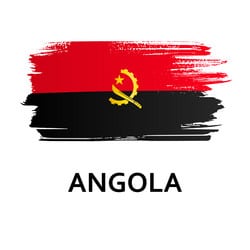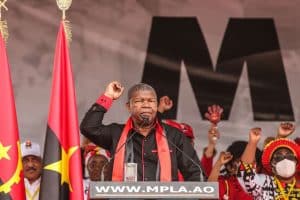Metro
Angola Population, Official Language And More.

The Portuguese colony of Angola was founded in 1575 with the arrival of Paulo Dias de Novais with a hundred Portuguese families and four hundred soldiers. Its center at Luanda was granted the status of city in 1605. The King of the Kongo soon converted to Christianity and adopted a similar political structure to the Europeans. The Popular Movement for the Liberation of Angola (MPLA) was founded in 1956 with the help of the clandestine Portuguese Communist Party, and from 1962 it was led by Agostinho Neto. It was one of the main forces that fought for Angola’s independence from Portugal.

Angola
The Population:
Angola has an estimated population of 36.7 million people as of 2023, making it the 8th most populous country in Africa. The population is composed of various ethnic groups, mainly Bantu peoples, such as the Ovimbundu, Kimbundu, Bakongo, Chokwe, and others. The population growth rate is about 3.2% per year, and the median age is 16.8 years. The Landmarks: Angola has many natural and cultural landmarks that attract visitors and reflect its history and diversity. Some of the most famous landmarks are: The Kalandula Falls, the second-largest waterfalls in Africa, with a height of 105 meters and a width of 400 meters. The Black Stones of Pungo Andongo, a group of mysterious rock formations that resemble animals and human figures. The Miradouro da Lua, a scenic viewpoint that overlooks a lunar-like landscape of cliffs and valleys. The Iron Palace, a prefabricated metal building that was allegedly designed by Gustave Eiffel and shipped to Luanda in the 19th century. The Mbanza Congo Vestiges, the remains of a former capital of the Kongo Kingdom that was inscribed as a UNESCO World Heritage Site in 2017.
The Official Language:
The official language of Angola is Portuguese, which was introduced during the colonial era and is spoken by about 80% of the population as a first or second language. Portuguese is used for administration, education, media, and business purposes. However, there are also 46 other languages spoken in Angola, mostly Bantu languages that have an institutional status, such as Umbundu, Kimbundu, Kikongo, Chokwe, Ngangela, and Kwanyama.
The Culture:
Angola has a rich and diverse culture that reflects its ethnic, historical, and geographical influences. Some of the aspects of Angolan culture are: The music, which is influenced by Portuguese, Brazilian, Cuban, and Congolese styles, and features genres such as semba, kizomba, kuduro, and angola rap. The literature, which is mostly written in Portuguese and includes renowned authors such as Agostinho Neto, Pepetela, José Eduardo Agualusa, and Ondjaki. The cuisine, which is based on staples such as cassava, corn, beans, rice, fish, and meat, and includes dishes such as funge, calulu, muamba de galinha, cocada amarela, and kissangua. The religion, which is predominantly Christian (mostly Catholic), but also includes traditional beliefs and practices among some ethnic groups.
The Economic Stability:
Angola is one of the largest oil producers in Africa and has a high GDP per capita compared to other sub-Saharan countries. However, it also faces many economic challenges such as: The dependence on oil revenues, which makes it vulnerable to price fluctuations and external shocks. The high levels of poverty, inequality, unemployment, and inflation that affect most of the population. The corruption, mismanagement, and lack of transparency that hinder good governance and accountability. The underdevelopment of infrastructure, health care, education, and social services that limit human development and quality of life. The GDP The Gross Domestic Product (GDP) of Angola is the total value of all the goods and services produced in the country in a given year. According to the World Bank, the GDP of Angola was worth 106.71 billion US dollars in 2022, which represents 0.05 percent of the world economy. The GDP of Angola is expected to grow slightly in the next few years, reaching 112.46 billion US dollars by 2025. However, Angola still faces many economic challenges, such as high inflation, unemployment, poverty, corruption, and dependence on oil exports. The Currency The currency of Angola is the kwanza, with the symbol Kz and the ISO code AOA. The kwanza was introduced in 1977, after Angola gained its independence from Portugal, and has undergone several changes and devaluations since then. As of January 2023, one US dollar is equal to 826.50 kwanzas. The kwanza is not widely accepted outside Angola, and most tourists and travelers need to exchange their foreign currency at banks or official bureaus. The Food The food of Angola is a mixture of indigenous African ingredients and cooking techniques, and Portuguese influences and ingredients brought over from other colonies, such as Brazil. The main staple ingredients of Angolan food include flour, beans and rice, fish (and seafood), pork and chicken, and various vegetables such as sweet potato, plantains, tomatoes, onions, and okra. The most popular food in Angola is called funge, which is a thick porridge made of corn or cassava flour. Funge is usually served with different sauces or stews, such as moamba de galinha (chicken stew with palm oil), calulu (dried fish with vegetables), or muamba de ginguba (peanut sauce). Major Cities Angola has 18 provinces, each with its own capital city. The largest and most populous city in Angola is Luanda, which is also the national capital and the main port of the country. Luanda has an estimated population of over 8 million people, and is a major economic, cultural, and political center of Angola. Other major cities in Angola include Huambo, which is the capital of Huambo province and has a population of about 1.5 million people; Lobito, which is the capital of Benguela province and has a population of about 1.2 million people; Benguela, which is the second-largest port city in Angola and has a population of about 800,000 people; and Cabinda, which is the capital of Cabinda province and has a population of about 700,000 people. Major Airport, Sea Port and Schools Angola has several airports, sea ports and schools that serve its population and visitors. The major airport in Angola is the Quatro de Fevereiro International Airport, located in Luanda. It handles domestic and international flights to various destinations in Africa, Europe, Asia, and South America. The major sea port in Angola is also located in Luanda, and it handles most of the country’s imports and exports, especially oil products. The major schools in Angola include public and private institutions that offer primary, secondary, vocational, and higher education. Some of the notable schools in Angola are the Agostinho Neto University, which is the largest public university in Angola; the Catholic University of Angola, which is the largest private university in Angola; the National Institute of Petroleum, which offers specialized training for the oil industry; and the National Institute of Telecommunications, which offers courses in information technology.





